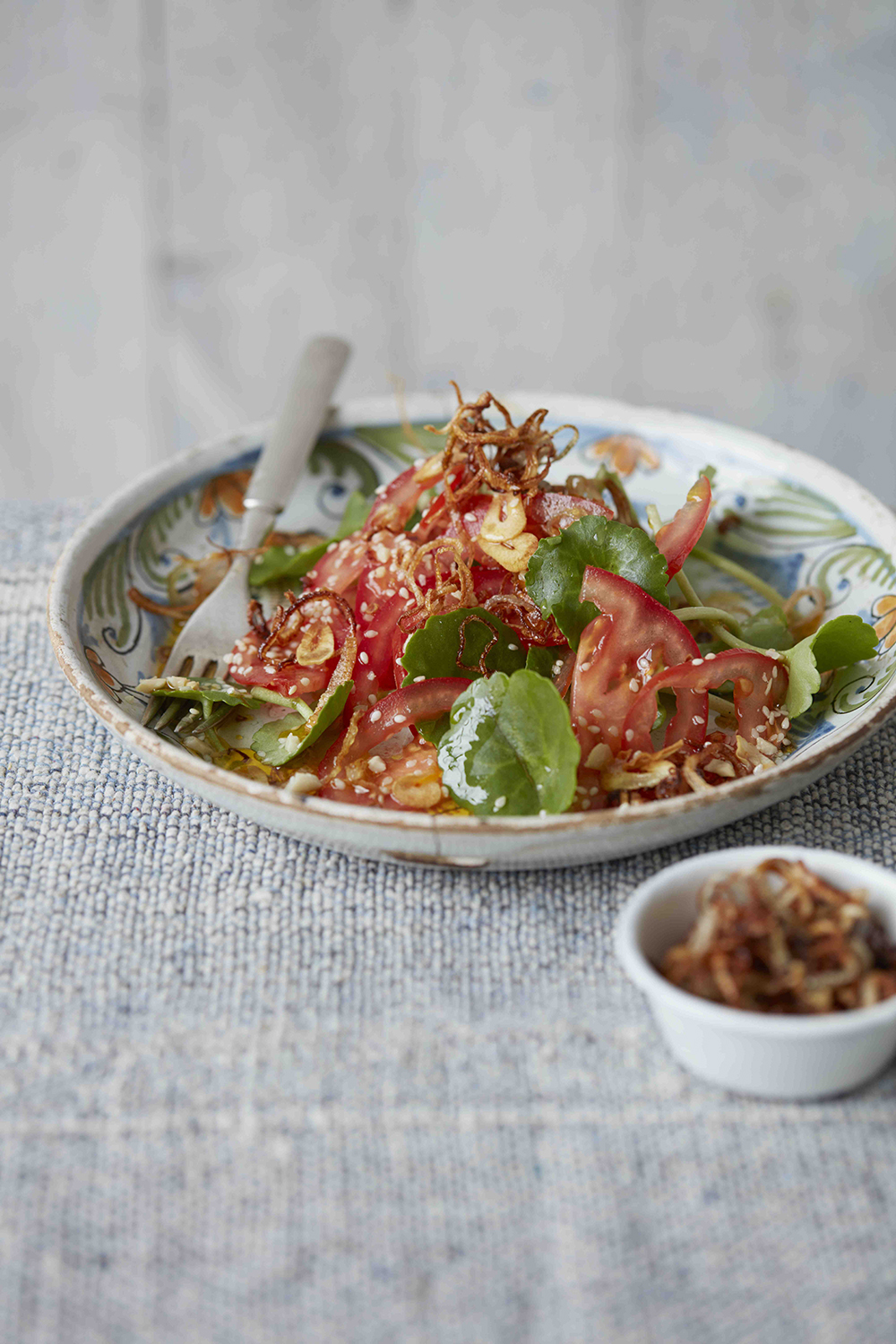The Darina Allen Column
 Our eating habits have changed drastically in the last few decades. One in eight Britons are now vegetarian or vegan, according to a recent report on food shopping. A further 21% claim to be flexitarian, eating a predominantly ‘plant based’ diet, occasionally supplemented with a little meat or fish. That amounts to a staggering one third of UK consumers that have reduced or removed meat entirely from their diet. This rapid and dramatic change is being fuelled by the perception that farm animals are one of the major contributors to CO2 emissions… However it is important to realise that those statistics were based on ‘feed lot’ systems rather than grass fed or pasture raised cattle.
Our eating habits have changed drastically in the last few decades. One in eight Britons are now vegetarian or vegan, according to a recent report on food shopping. A further 21% claim to be flexitarian, eating a predominantly ‘plant based’ diet, occasionally supplemented with a little meat or fish. That amounts to a staggering one third of UK consumers that have reduced or removed meat entirely from their diet. This rapid and dramatic change is being fuelled by the perception that farm animals are one of the major contributors to CO2 emissions… However it is important to realise that those statistics were based on ‘feed lot’ systems rather than grass fed or pasture raised cattle.
Animal welfare issues are high on the list of concerns that have swayed the 18-34 year olds. This age group particularly are becoming much more curious and concerned about how their food is being produced. Many have lost trust in multinational food companies, supermarkets, governments and the health service. They are confused by food labelling and are becoming more and more desperate as food allergies and intolerances grow exponentially. Consumers are demonstrating increasing concern about the impact of our food choices and behaviour on the environment.
The focus on the effect of plastic on our oceans (see BBC’s, Blue Planet 2) and the fact that up to 9 different types of plastics were found in human stools in a recent study conducted by the Environment Agency Austria, has shocked people into action.
We want our governments to legislate for less plastic packaging and we want our supermarkets to be proactive about reducing plastic.
For the first time this year The Good Food Guide highlighted restaurants with vegan menus. The UK supermarket group Waitrose, have created vegan sections in 134 of their stores and launched a range of more than 40 vegan and vegetarian meals. This is not going to change anytime soon. My gut feeling is that a plant based diet with lots of fresh organic vegetables, fresh herbs and grains, organic eggs, dairy and some meat and fish is the best for humans, animals and the planet.
In the sage words of Michael Pollan, “Eat food, mostly plants and not too much”.
In this column I often include vegetarian and vegan dishes without necessarily highlighting the fact, but from now on I will - but do go out of your way to find chemical free food and if you’ve decided to follow a vegan diet you’ll need to source even more nutrient dense foods and supplement with B12 which cannot be sourced from plants.
Vegetable and Tofu Curry
You’ll love this curry, even ardent curry haters can’t get enough of this deliciously spiced dish. It’s also an excellent base for lots of beans and pulses.
Serves 4 -6
2 large garlic cloves, crushed
1–2 chillies, deseeded and roughly chopped
zest of 1 organic lemon or 2 limes
110g coriander leaves and stalks (coarsely chopped)
60g cashew nuts, toasted and roughly chopped
1 ½ tablespoon grated ginger
2 teaspoons turmeric
2 teaspoons roasted and ground cumin
1 teaspoon salt
1 x 400 ml tin of coconut milk
400ml homemade vegetable stock
500g pumpkin or sweet potato, diced 2cm approx
225g firm tofu, diced 2cm approx
225g French beans, green or a mixture of green and yellow
1 small cauliflower, approx. 350g in small florets
lots of coarsely chopped coriander
lemon or lime wedges
Whizz the garlic, chilli, citrus zest, roughly chopped coriander leaves and stalks, cashew nuts, ginger, turmeric, cumin and salt to a puree in a food processor.
Heat 4 tablespoons of extra virgin olive oil in a saucepan, add the pureé, stir and cook for 3 – 4 minutes.
Add the whisked coconut milk and stock, bring to the boil and simmer for 8 – 10 minutes. Add the chunks of sweet potato or pumpkin or a mixture, return to the boil cover and simmer for 10 minutes.
Add the beans, cauliflower florets and tofu chunks, bring back to the boil, cover and simmer for 10 minutes, add the vegetables and simmer for a further 2-3 minutes until the vegetables are cooked through.
Add a little lemon or lime juice if possible.
Taste and tweak the seasoning if necessary. Sprinkle with lots of coarsely chopped coriander and serve with lime or lemon wedges.
 Burmese Pennywort Salad
Burmese Pennywort Salad
Serves 4
175g pennywort
2-3 shallots, sliced and soaked in ice cold water
2 large cloves garlic, thinly sliced
Oil
Shallot oil
1 tablespoon crushed peanuts
1 large or 2 small tomatoes, halved and thinly sliced
1 tablespoon freshly squeezed lime juice
2-3 tablespoons sesame seeds
2 teaspoons fermented bean paste
3 tablespoons fried shallots
Fish sauce or salt
Wash and dry the pennywort leaves.
Slice the garlic paper thin and allow it to dry on kitchen paper.
Heat some peanut oil in a frying pan and cook on a medium heat until crisp and golden.
Drain on kitchen paper.
Put the pennywort onto a plate. Sprinkle the garlic and shallot oil over the top, then the freshly squeezed lime juice, fermented bean paste, fish sauce, thinly sliced tomato and sesame seeds.
Toss and mix with your clean fingers as the Burmese do. Add most of the fried shallots and half the peanuts. Toss again. Taste, correct seasoning.
Divide between 4 plates, sprinkle with the remainder of the fried shallots and peanuts.
Serve immediately, each salad is made to order.
Sri Lankan Beetroot Curry
Serves 4
2-3 tablespoons sunflower oil
3 cloves garlic, chopped
50g (1¾oz) red onion, chopped
5 Curry leaves
8cm (3inch) piece of cinnamon stick
500g (1lb 2oz) beetroot, peeled and cut into 4cm (1½in) cubes
1½ teaspoon untoasted curry powder
10 fenugreek seeds
5 green chillies
225ml (8fl.oz) coconut milk, whisked
Salt and freshly ground pepper
Put oil in a deep frying pan over a medium heat, add the chopped garlic, onion, curry leaves, curry powder and cinnamon to the pan, stir and cook for 2 minutes. Then add the beetroot, stir and add the fenugreek seeds, chillies and some salt. Bring to the boil, add the coconut milk, and continue to cook for about 20 minutes or until the beetroot is tender. Season to taste.
Myrtle Allen’s Poached Pears
A super simple recipe that transforms the flavour of even nondescript pears. Another inspired recipe from Myrtle Allen’s The Ballymaloe Cookbook, published in 1977. Maybe double the recipe, they will keep for weeks in a Kilner jar in your fridge.
6 pears
1 lemon
4 oz (110g) sugar
Peel the pears thinly and core carefully. Keep whole or cut in half if you choose, keeping a good shape. Put them in a pan that will just fit them nicely. Add the sugar, a few thin strips of lemon rind and the juice of the lemon. Cover with a well fitting lid and cook gently until soft. Cool and serve. Dessert apples may be cooked like pears.
Note: Pears may also be poached in a light syrup of 2 parts water to 1 part vanilla sugar with a couple strips of lemon peel. (Use 1 pint of water to 2 lb sugar)
2019 Cookery School Brochure available now…
The Ballymaloe Cookery School 2019 schedule is out now on our website. We have lots of exciting courses planned for 2019 including our ever popular 12 Week Certificate Course, next one scheduled for January 7th, 2019. As our 2018 schedule comes to a close we have a few Christmas themed courses with spaces still available. Check it out on www.cookingisfun.ie
http://www.cookingisfun.ie/
https://www.instagram.com/darina_allen
https://www.instagram.com/ballymaloecookeryschool
'30 Years at Ballymaloe' - Bord Gáis Avonmore Cookbook of the Year 2013
Good Food Ireland Cookery School of the Year 2012/2013





There are currently no comments
Leave a comment
Not a member? Register for your free membership now!
Or leave a comment by logging in with: